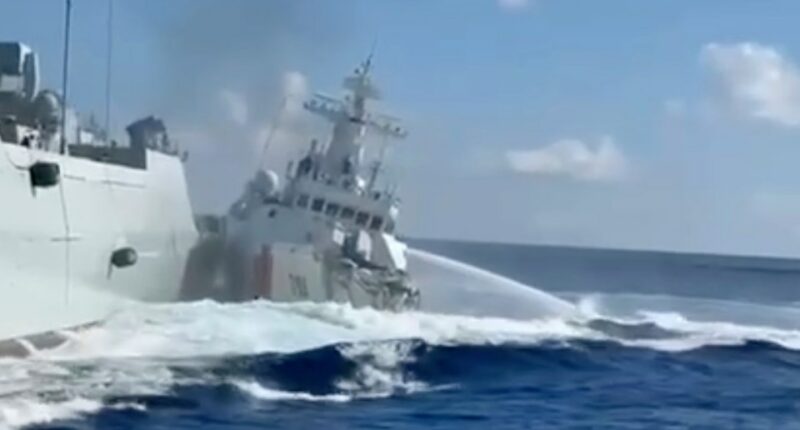Share this @internewscast.com
THIS is the moment a Chinese navy warship crashed into its own coast guard vessel while chasing a Philippine patrol boat in South China Sea.
Dramatic footage released by Manila depicts a large Chinese warship marked with the number 164 on its hull colliding with a China Coast Guard ship, producing a loud crash.
It showed the stricken Chinese vessel still afloat but with its entire bow crumpled inward.
The Chinese ship sustained major damage to its hull after crashing into its own coast guard ship.
The collision took place near the contested Scarborough Shoal in the disputed South China Sea.
Footage before the crash shows the PLA’s navy vessel coming dangerously close to the Philippine Coast Guard ship in a show of force.
The Philippine Coast Guard was accompanying boats that were distributing aid to fishermen in the area when Chinese navy vessels started pursuing them, according to spokesman Commodore Jay Tarriela.
He stated: “The [China Coast Guard vessel] CCG 3104, which was pursuing the [Filipino coast guard vessel] BRP Suluan at high speed, executed a high-risk maneuver from the [Philippine] vessel’s starboard quarter, resulting in the collision with the PLA’s Navy warship.”
“This resulted in substantial damage to the CCG vessel’s forecastle, rendering it unseaworthy.”
The Philippine vessel was also “targeted with a water cannon” by the Chinese but “successfully” evaded it, Tarriela’s said.
The crew members aboard the smaller Chinese vessel had been visible in its front section just before the collision.
Tarriela’s said: “We’re not sure whether they were able to rescue those personnel who were in front prior to the collision.
“But we are hoping that these personnel are in good condition.”
Manila says the Chinese crew “never responded” to the Philippine ship’s offer of assistance.
Gan Yu, a Chinese coast guard spokesperson, confirmed that a confrontation had taken place without mentioning the collision.
“The China Coast Guard implemented necessary actions per the law, incorporating monitoring, external pressing, blocking, and controlling the Philippine vessels to force them away,” he mentioned.
China’s Ministry of Foreign Affairs did not confirm or deny the collision when asked about it.
The crash is the latest in a series of confrontations between China and the Philippines in the South China Sea.
Beijing claims the region almost entirely despite an international ruling that the assertion has no legal basis.
More than 60 per cent of global maritime trade passes through the disputed waterway.
During a morning news conference, Philippine President Ferdinand Marcos affirmed that the country’s patrol vessels would “continue to be present” in the area to uphold defense efforts.
He added the country’s navy would also exercise Manila’s sovereign rights over the region.
The Scarborough Shoal – a triangular formation of reefs and rocks – has been a contentious zone between the nations since China took control from the Philippines in 2012.
Why is the South China Sea contested?
THE South China Sea is an arena for a power struggle between different powers.
Several countries claim the rights to large portions of its territory based on historical rights.
The problem is, some of these claims overlap.
China’s claim is based on a vague “nine-dash line” on some maps, which is not generally recognised in international law.
Many countries argue that China’s claims violate the United Nations Convention on the Law of the Sea (UNCLOS).
Other countries, like Vietnam, the Philippines, Malaysia and Brunei, are eager not the concede the territory, because it is known to hold valuable natural assets like natural resources.
One major point of tension is the Spratly Islands, with multiple countries claiming ownership of various islets and reefs.
China has been criticized for constructing artificial islands in the South China Sea and deploying military equipment there.
The latest announcements for a seabed research centre will further inflame this anger.





















